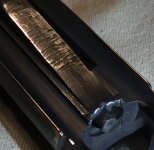I have 4 buffers, 5.4, 6.5, 6.7 and a custom 8.4 ounces. All of them reform similarly in my semi PCC and FA lower with a Foxtrot arms Glock 9mm upper with the fancy forward charging handle. Rate of fire was about the same. Thanks for the tip about heat treating, I will try that out when I get it smoothed out!
If you're interested in slowing the ROF, I would look into the Kynshot 9mm hydraulic buffer and a Tubbs 300 BLK OUT spring in a Vltor B5 length receiver extension. The best way I had found 15 years ago was the Enidine hydraulic buffer and the AAC reduced power recoil spring in a carbine length receiver extension. The stronger the recoil spring, the higher the ROF, as a stronger spring increases the speed of the return of the bolt. A heavier buffer does slow the speed of the bolt group, but part of the problem with the blowback system is the recoil pulse is all at once.
Think of the direct impingement of of 5.56X45. The gun power is ignited. The bolt is locked into the barrel extension so that initial recoil pulse is contained inside the receiver. The bullet passes the gas port and some of the gas is directed into the bolt/carrier piston. The piston pushes the carrier back which cams the bolt to unlock and pushes the carrier back. The amount of gas should be just enough to operate the bolt group to cycle. The bolt group cycles, ejects the empty shell then strips and chambers a new round.
With the blowback system all of the recoil energy of the pistol round goes into the bolt group all at once. The greater the dwell time (the time that the bullet is in the barrel so there is pressure on the bolt) the more energy is transferred to the bolt. 9X19 Luger has about the same energy at the muzzle as 45 ACP, yet the blow back bolt group for .45 must have a heavier buffer. Why, because the heavier .45 bullet has a long dwell time. So more energy is transferred into the bolt group.
I think that if the transfer of energy is spread out over time, that softens the recoil pulse, like the DI system. Granted the DI system impulse in a rifle caliber system has more total energy to deal with, but I think that the DI rifle caliber system shoots softer than the pistol caliber blowback system in an AR. The softer shooting PCCs are those that that transfers some of the recoil pulse into the receiver. The MP5 has been the gold standard of 9mm carbines. Why, because the roller delayed blowback system transfers some of the recoil pulse into the receiver. So the bolt group can be lighter. The lower the mass moving around in the gun, the less movement the gun will tend to have. The new CMMG radial delayed blowback system has less felt recoil. Why, because the angled bolt lugs transfer some of the recoil pulse into the receiver of the firearm. CMMG has had problems with the ejector spring system. This has shown to be a more of a problem for higher volume/full auto applications.
If you want to lower your ROF in the blowback system, I would look into a lighter spring and a buffer that slows the rate of loading mass to the bolt group like a hydraulic or mechanical buffer like the MGI. I don't know as case hardening would help your existing bolt very much. Case hardening only effects a couple of thousands deep. I would think that the bolt would need to be made from tougher/harder steel. As posted earlier, all of the 9mm blowback bolts I had ramped needed no additional heat treating because the material that they were made from was so strong. Good luck with your bolt project.
Scott






